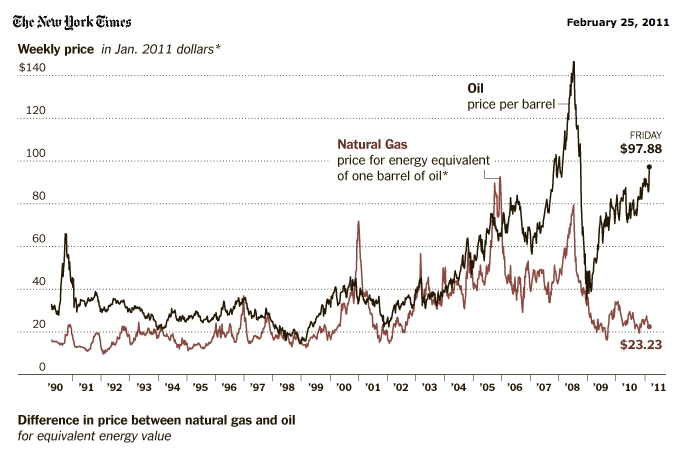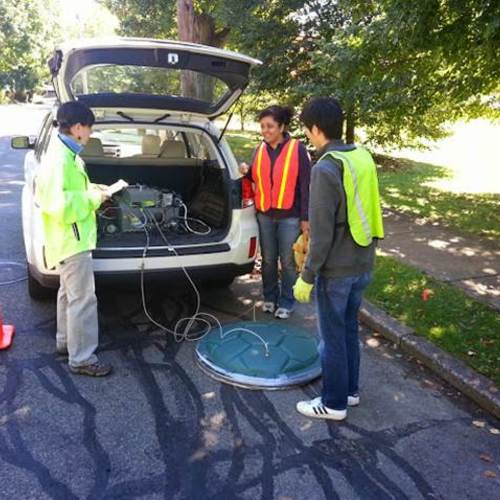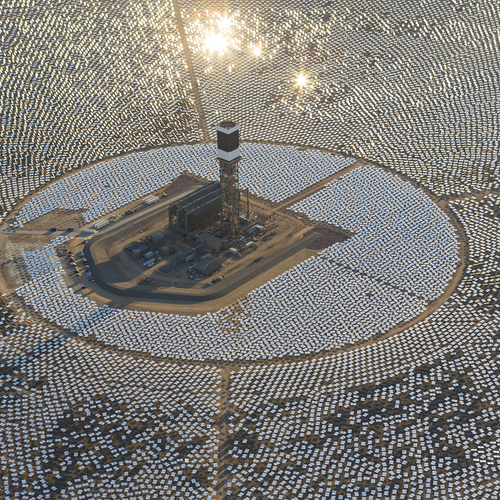Image Credit: The New York Times, February 26, 2011
Image Credit: The New York Times, February 26, 2011 Huge new reserves of natural gas have been found in the Marcellus Shale formation.
Image Credit: ReelFacts, adapted from USGS How "Fracking" works.
Image Credit: Clean Water for North Carolina Fracking wells in the Pennsylvania countryside.
Image Credit: PhillyWorkersVoice
Natural gas has been in the news a lot recently.
On the economics side, we are seeing a fascinating divergence of petroleum and natural gas prices. For decades, oil and gas prices have tracked pretty closely — natural gas prices rising and falling as international political events boosted or depressed oil prices. Today, for the first time, as oil prices are surging, natural gas prices are still falling. In the last few weeks, natural gas prices have fallen to historic lows, compared with oil.
A little over a week ago, the New York Times reported that on an apples-to-apples comparison (in which natural gas prices were converted to barrel-of-oil-equivalents), oil was four times as expensive as natural gas. And the price of oil has risen nearly $10 per barrel since then. That difference in price between these two energy sources has never been so great.
One significant implication is a significant regional disparity in hardship with home heating. About 55% of the country heats with natural gas, and those homeowners and renters have seen their heating costs go down. The 7% of Americans who heat with heating oil, however, have seen heating costs rise dramatically. In New England, heating oil prices have risen to over $3.60 per gallon.
The drop in price of natural gas has been driven by oversupply. We’re finding and producing more natural gas, and that has depressed prices. And we’re discovering huge new deposits of this energy source — most prominently with the vast Marcellus Shale deposits in Pennsylvania, New York, Ohio, and West Virginia.
Named for the village of Marcellus, New York, this black shale formation was believed in 2002 to contain 1.9 trillion cubic feet (TCF) of natural gas (the U.S. uses about 23 TCF of natural gas per year), but by 2009, that estimate by the U.S. Department of Energy (DOE) had increased to 269 TCF!
Environmental benefits of natural gas
We have long looked to natural gas as the cleanest of fossil fuels. Burning it emits little nitrogen or sulfur pollution. Natural gas is mostly methane (a molecule comprised of one carbon atom and four hydrogen atoms); it has the lowest carbon-to-hydrogen ratio of any hydrocarbon. That means burning natural gas releases more water vapor and less carbon dioxide than burning oil or coal (which have higher carbon-to-hydrogen ratios).
This is significant, because carbon dioxide is our most significant greenhouse gas — the leading culprit in global climate change. Burning natural gas instead of coal or oil will reduce the pace of climate change, proponents argue. The combustion of natural gas releases 117 pounds of CO2 per million Btus of heat produced, while burning the same heat content of gasoline emits 156 pounds, fuel oil 161 pounds, and coal 205 to 227 pounds, according to DOE.
Environmental concerns
Even as we tout the environmental benefits of natural gas, it has come under greater environmental scrutiny recently. For starters, the extraction and processing of natural gas releases some methane directly into the atmosphere, and methane is about 20 times as potent a greenhouse gas as CO2. Some estimate that while burning natural gas instead of coal to generate electricity results in only about half the CO2 emissions, when you factor in the direct emissions of methane, the greenhouse gas reduction is only about 25% (considering CO2-equivalents).
In addition, with Marcellus Shale natural gas production, there is significant potential for groundwater and drinking water contamination. This is because a practice called hydraulic fracturing or “fracking” involves injecting a mixture of water, sand, and various chemicals deep underground at extremely high pressure (as much as 10,000 psi) to fracture the underlying rock and free trapped pockets of natural gas.
The process is very water-intensive — with each fracking operation requiring as much as 5 million gallons of water, according to FracTracker, a project of the Center for Healthy Environments & Communities at the University of Pittsburgh. A single well may generate 1,000 tons of drilling waste that can include not only water and mud but also a range of salts, heavy metals, and naturally occurring radioactive material; much of that waste is held in surface impoundments. Leakage from those impoundments and the fracturing of rock sediments deep underground is contaminating groundwater throughout the region — the subject of a 2010 documentary film, Gasland.
Currently, fracking is exempt from the Safe Drinking Water Act — through a special provision in the 2005 Energy Policy Act passed during the George W. Bush Administration. That provision is known as the Halliburton Loophole; according to the New York Times it was added to the bill at the insistence of Vice President Dick Cheney to strip the U.S. Environmental Protection Agency of the authority to regulate this practice.
Clearly, natural gas can — and should — play a role in a shift to cleaner, lower-carbon energy sources, but there’s no free lunch with this energy source. By understanding the impacts of natural gas extraction, we are reminded of the need to improve efficiency — no matter what the energy source. The less we use the better.
In addition to this Energy Solutions blog, Alex contributes to the weekly blog BuildingGreen’s Product of the Week, which profiles an interesting new green building product each week — most recently a new cotton insulation. Alex is founder of BuildingGreen, Inc. and executive editor of Environmental Building News. To keep up with his latest articles and musings, you can sign up for his Twitter feed.
Weekly Newsletter
Get building science and energy efficiency advice, plus special offers, in your inbox.
















8 Comments
Natural Gas
I really like natural gas... to power cars, trucks, and possibly airplanes with. I like electricity to power stationary objects with, like you house. If you take the same natural gas you would otherwise burn in your 92% efficient furnace, and instead burn it in a power plant, the electricity that is generated (in a relatively newer generation power plant) is about 65% efficient. If you then use a 270% efficient heat pump to heat your house, you are about 175% efficient with you use of the natural gas, a little less after considering line losses, which only average about 6.5% nationwide, according to the US Dept. of Energy. This is a great way to use natural gas, until we have developed more renewable energy sources, and reduced our loads.
shale gas
There seems to be some confusion in this article. There is a huge difference between conventional natural gas and that which is extracted from shale. The former is relatively benign as far as fossil fuels can be called benign.About 90% of the gas in a deposit can be extracted. With hydraulic fracturing of the shale on the other hand 80% of the gas remains after the well is closed.Over time,the pressure builds slowly and irrevocably as gas leaches out of the disturbed massif . At the same time the well structure will be degrading. Eventually the costs of trying to handle all those methane leaks will be astronomical.(20% greater green house gas damage than CO2!). How many wells do you have in the U.S. now? Better get started.(See: http://www.facebook.com/note.php?note_id=189917767706479 )
Good and bad natural gas
Ingrid,
Good point about conventional vs. shale-sourced natural gas. The problem is that natural gas is a commodity. I can't order gas only from conventional wells. It all goes into the same pipeline. So, as this newer (bad) natural gas enters the market, it brings down the environmental performance of all natural gas.
Response to Ted Clifton
You really have hit on the best way to "power" homes for now and the future. I want to add that when you can turn off the natural gas to the home completely, you save the "monthly service fee". In a superinsulated home, that fee can be 10-50% of the energy bill.
That can increase your calculated 175% energy efficiency number up to at least a 200% "economic efficiency" for a small low energy home.
But if natural gas costs stay this incredibly low, then we'd have to start considering these things:
http://www.hondapowerequipment.com/products/homeenergy/freewatt.aspx
shale gas
I would just like to correct a typo in my last comment. It is 95% of conventional gas that is recovered - not 90%.
Also Kevin Dickson seems to have missed the point: Shale gas ( the American choice for the future)
is something no economy can survive over time. The ''externalities'' are too costly.See my comments above.
Response to Ingrid
Sorry, I should have said that it's the best way to power homes in the future while natural gas for electricity is phased out by renewable electricity generation.
Shale Gas
Appreciate the comments that we should build as efficiently as possible, and use renewables as much as we can - I agree totally. When using fossil fuel, natural gas seems best, and you really can't (as a consumer) choose the source. Fracing has potentially serious problems, and both EPA and (here in NY) DEC are looking at it very hard. NY should complete its SGEIS soon, and I believe will issue responsible regulations for control of the process, start to finish. DEFINITELY want to move cautiously here, I think PA went too quickly. I'm not sure GASLAND alone is a very good source of information, since many geologists and many regulators I know feel it is not highly factual or accurate, even though a fairly good quality video production.
Response *2 to Kevin Dickson
Freewatt almost has it right... when they start using the electricity they generate with their Honda Generator to power a heat pump, and harvest the heat energy off the generator to augment the heat pump, they will approach the kind of efficiencies I am advocating. Kevin is right on target with his comment that the use of natural gas used in this way should only be used to get us through to the point of using all renewables.
There will come a day, hopefully not for several centuries, when we have used the last drop of fossil fuels. The more we can reduce the use today, the longer our finite supply will last. The mobility we have become accustomed to will no longer be available once our resources are gone.
Log in or create an account to post a comment.
Sign up Log in